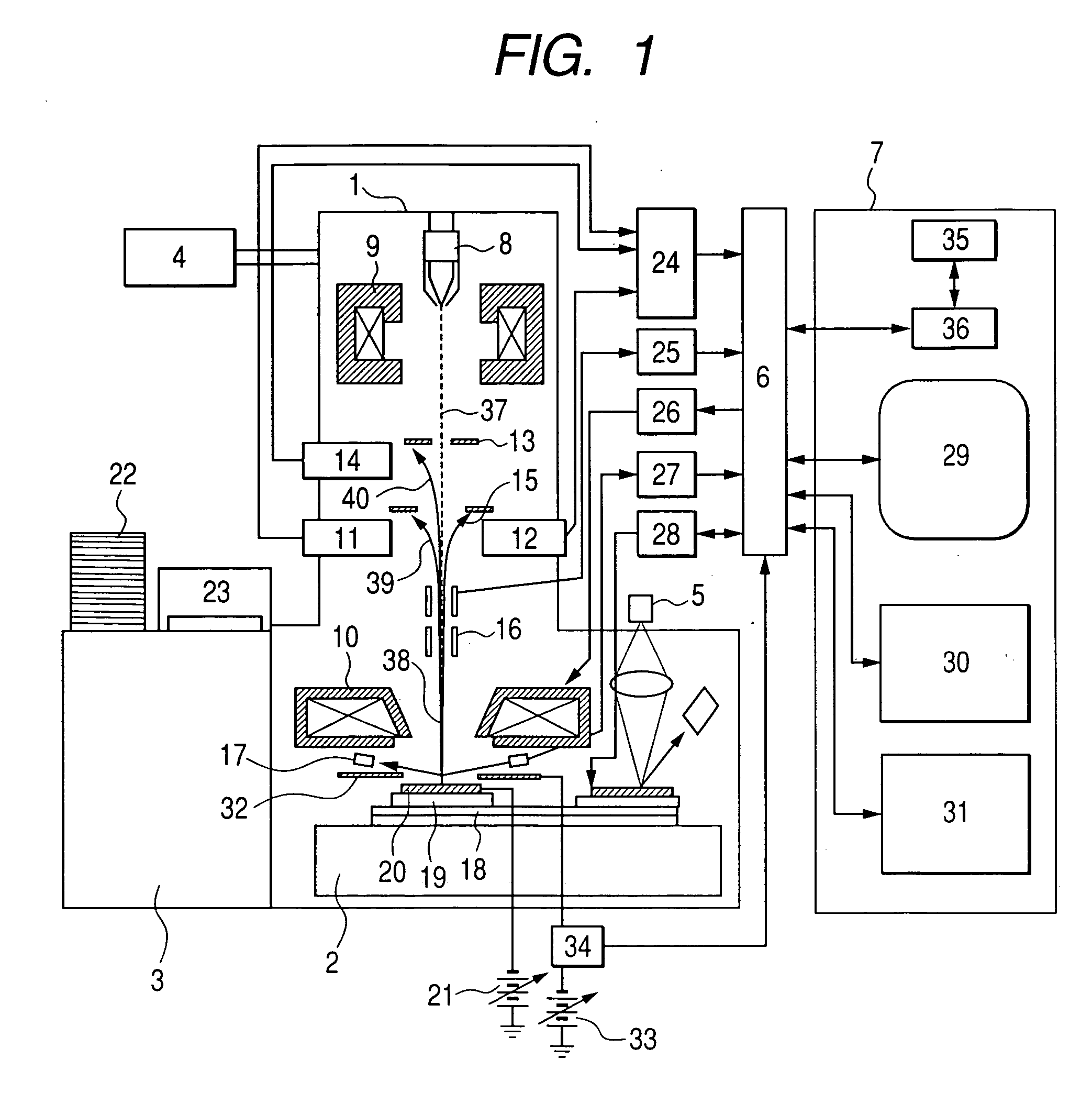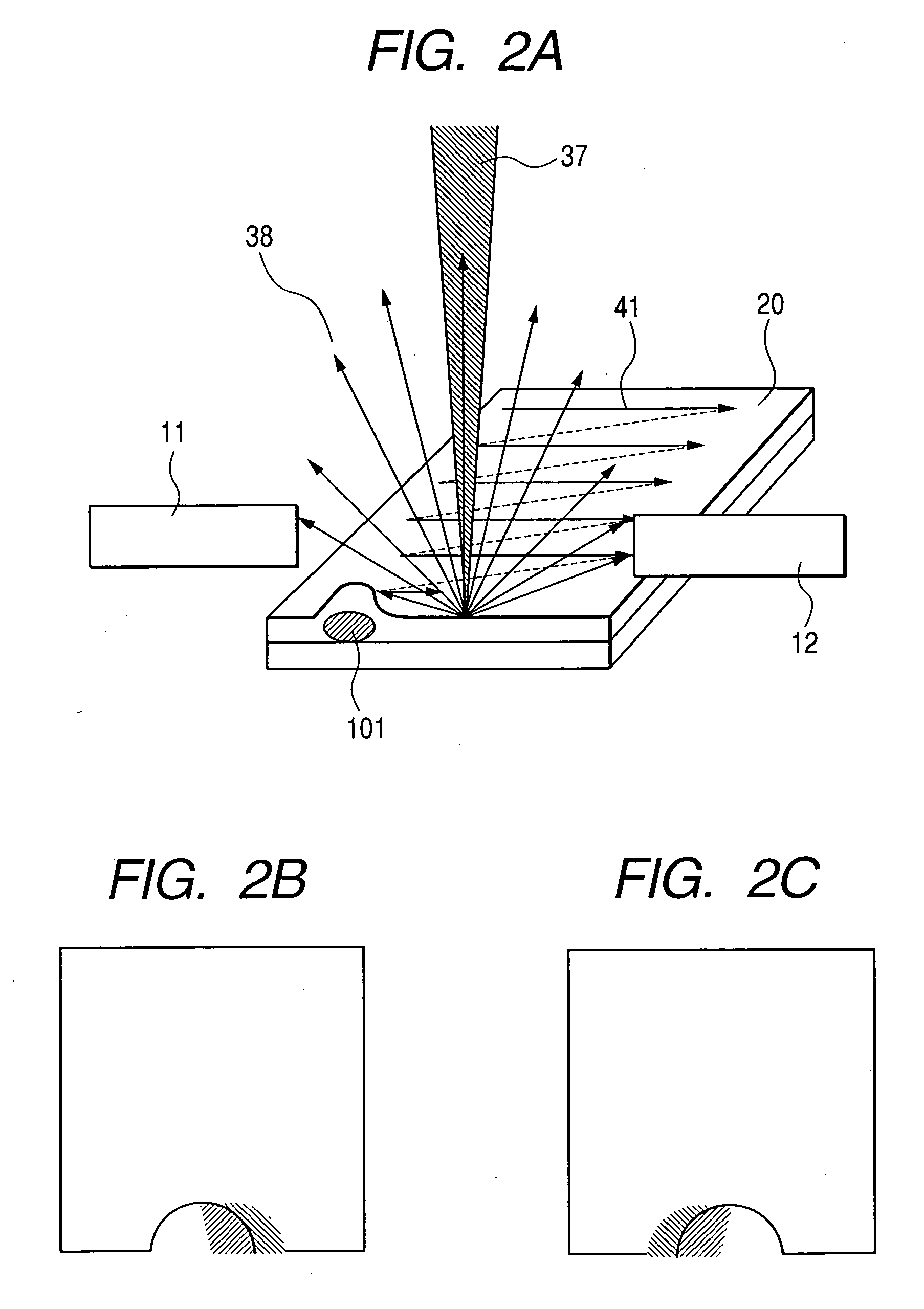Inspection method and inspection apparatus using charged particle beam
a technology of charged particle beam and inspection apparatus, which is applied in the direction of discharge tube/lamp details, material analysis using wave/particle radiation, nuclear engineering, etc., can solve the problems of low shadow contrast, low sensitivity, and inability to emphasize contrast, and achieve high sensitivity. , the effect of high sensitivity
- Summary
- Abstract
- Description
- Claims
- Application Information
AI Technical Summary
Benefits of technology
Problems solved by technology
Method used
Image
Examples
first embodiment
[0031] In this embodiment, an example of defect classification using a review SEM. FIG. 1 shows an example configuration of a review SEM. This apparatus comprises an electro-optic system 1, a stage mechanism system 2, a wafer carrying system 3, an evacuation system 4, an optical microscope 5, a control system 6, and an operation unit 7.
[0032] The electro-optic system is composed of an electron source 8, a condenser lens 9, an objective lens 10, a first detector plate 11, a second detector plate 12, a first reflector plate 13, a third detector plate 14, a second reflector plate 15, a deflector 16, a wafer height detector 17, an electrode 32 disposed opposite to the stage, an electrode power supply 33, and an electrode power supply control unit 34.
[0033] The stage mechanism system 2 includes an XY stage 18, a holder 19 to hold a wafer as a specimen, and a retarding power supply 21 to apply a negative voltage to the holder 19 and wafer 20. To the XY stage 18 is attached a position de...
second embodiment
[0046] Now, a second embodiment is described. FIG. 8 shows the configuration of the second embodiment. In this embodiment, a so-called ExB deflector 201 for deflecting secondary electrons is disposed on the light axis of a primary electron beam. The other configuration is the same as that of the first embodiment. The term ExB deflector here is a deflector overlapping electric field and magnetic field, wherein, for the primary electron beam, the amount of deflection by electric field and that of magnetic field are set so that they become the same in opposite direction from each other to cancel out the deflection effect of each field, and, electric field and magnetic field acts on secondary electrons in such a direction in which the amount of deflection by electric field becomes equal to that of magnetic field, to thereby deflect only the secondary electrons independently.
[0047]FIG. 9 shows the operation of the second embodiment. The central trajectory 202 of secondary electrons is d...
third embodiment
[0052] Now, a third embodiment is described. The entire configuration is similar to that of the second embodiment shown in FIG. 8. In this embodiment, the ExB deflector is composed of a 4-polar electrode and a magnetic pole, and secondary electrons can be deflected at any azimuth. As a result, it is possible to align the secondary electrons not only in the direction (x direction in FIG. 9) of separating the reflector plate 15 as shown in FIG. 9, but also in the direction (y direction) perpendicular to the surface of the page on which FIG. 9 is drawn. This allows correction of a displacement in the y direction of the central trajectory of secondary electrons relative to the opening of the reflector plate 15. It is also possible to adjust so that secondary electrons impinge on the reflector plate in a desired manner.
PUM
 Login to View More
Login to View More Abstract
Description
Claims
Application Information
 Login to View More
Login to View More - R&D
- Intellectual Property
- Life Sciences
- Materials
- Tech Scout
- Unparalleled Data Quality
- Higher Quality Content
- 60% Fewer Hallucinations
Browse by: Latest US Patents, China's latest patents, Technical Efficacy Thesaurus, Application Domain, Technology Topic, Popular Technical Reports.
© 2025 PatSnap. All rights reserved.Legal|Privacy policy|Modern Slavery Act Transparency Statement|Sitemap|About US| Contact US: help@patsnap.com



